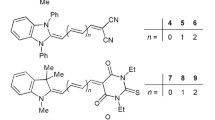Abstract
We investigated the characteristics of modified forms of bacteriorhodopsin in which the native retinal chromophore is replaced by a chemical analog (“bacteriorhodopsin analogs”), embedded in a polymer film. We found they displayed differential absorption spectra and kinetic curves for the most long-lived intermediates of the BR photocycle. We also studied the influence of chemical reagents on the functioning of bacteriorhodopsin analogs in polymeric films. We found that the immobilization of BR analogs in polymer leads, as in the case of native BR, to a slowing down of their photocycles. Kinetic analysis showed that M-like state intermediates of all the BR analogs have a longer dark relaxation time than native BR. The retention and retardation of the photocycle in these films suggest that films based on BR analogs can be used as photochromic materials. Moreover, 4-keto BR seems to be more promising for this application as compared not only with native BR, but also with other analogs of BR studied in this work.




Similar content being viewed by others
References
Aharoni A, Ottolenghi M, Sheves M (2002) Photoreduction of bacteriorhodopsin Schiff base at low humidity. A study with C13=C14 nonisomerizable artificial pigments. Photochem Photobiol 75:668–674
Becher BM, Cassim JY (1975) Improved isolation procedures for the purple membrane of Halobacterium halobium. Prep Biochem 5(2):161–178
Birge RR (1990) Nature of the primary photochemical events in rhodopsin and bacteriorhodopsin. Biochim Biophys Acta 1016(3):293–327
Brown LS, Ernst OP (2017) Recent advances in biophysical studies of rhodopsins—oligomerization, folding, and structure. BBA 1865:1512–1521
Druzhko A, Chamorovsky S (1995) The cycle of photochromic reactions of bacteriorhodopsin analog with 4-keto-retinal. BioSystems 35:133–136
Druzhko AB, Chamorovsky SK, Lukashev EuP, Kononenko AA, Vsevolodov NN (1995) 4-Keto-bacteriorhodopsin films as a promising photochromic and electrochromic biological material. BioSystems 35:129–132
Druzhko AB, Shakhbazian VYu, Alvarez R, de Lera AR, Weetall HH (2001) Photoinduced transformation of 14-F-bacteriorhodopsin gelatin films based on both wild type and D96N mutant. Biosystems 59:53–60
Druzhko AB, Dyukova TV, Pirutin SK (2017) Some factors affecting the process of photoinduced hydroxylaminolysis in different bacteriorhodopsin-based media. Eur Biophys J 46(6):509–515
Dyukova T, Vsevolodov N (2017) Photochromic composition and materials containing bacteriorhodopsin. Eur Biophys J 46:509–515
Fábián L, Heiner Z, Mero M, Kiss M, Wolff EK, Ormos P, Osvay K, Dér A (2011) Protein-based ultrafast photonic switching. Opt Express 19:18861–18870
Fábián L, Mathesz A, Dér A (2015) Acta Biol Szeged 59(Suppl. 2):189–202
Friedman N, Ottolenghi M, Sheves M (2003) Heterogeneity effects in the binding of all-trans retinal to bacterio-opsin. Biochemistry 42(38):11281–11288
Ganea C, Gergely C, Ludmann K, Varo G (1997) The role of water in the extracellular half channel of bacteriorhodopsin. Biophys J 73:2718–2725
Hampp N (2000) Bacteriorhodopsin as a photochromic retinal protein for optical memories. Chem Rev 100:1755–1776
Jussila T, Tkachenko NV, Parkkinen S, Lemmetyinen H (2001) Kinetics of photo-active bacteriorhodopsin analog 3,4-didehydroretinal. J Photochem Photobiol B 62:128–132
Knoblauch C, Griep M, Friedrich C (2014) Recent advances in the field of bionanotechnology: an insight into optoelectric bacteriorhodopsin, quantum dots, and noble metal nanoclusters. Sensors 14(10):19731–19766
Korchemskaya E Ya, Stepanchikov DA, Druzhko AB, Dyukova TV (1999) Mechanisms of nonlinear photoinduced anisotropy in bacteriorhodopsin and its derivatives. J Biol Phys 24:201–215
Korchemskaya E, Stepanchikov D, Dyukova T (2000) Photoinduced anisotropy in chemically-modified films of bacteriorhodopsin and its genetic mutants. Opt Mater 14(2):185–191
Korenstein R, Hess B (1977) Hydration effects on the photocycle of bacteriorhodopsin in thin layers of purple membrane. Nature 1977(270):184–186
López S, Rodríguez V, Montenegro J, Saá C, Alvarez R, de Lera AR, Simón R, Lazarova T, Padrós E (2005) Synthesis of N-heteroaryl retinals and their artificial bacteriorhodopsins. ChemBioChem 6:2078–2087
Magyari K, Bálint Z, Simon V, Váró G (2006) The photochemical reaction cycle of retinal reconstituted bacteriorhodopsin. J Photochem Photobiol B 85(2):140–144
Mahyad B, Janfaza S, Hosseini E (2015) Bio-nano hybrid materials based on bacteriorhodopsin: potential applications and future strategies. Adv Colloid Interface Sci 225:194–202
Oesterhelt D, Schumann L (1974) Reconstitution of bacteriorhodopsin. FEBS Lett 44:262–265
Oesterhelt D, Schumann L, Gruber H (1974) Light-dependent reaction of bacteriorhodopsin with hydroxylamine in cell suspensions of Halobacterium halobium: demonstration of an apomembrane. FEBS Lett 44:257–261
Ormos PL, Fábián L, Oroszi EK, Wolff J, Ramsden J, Dér A (2002) Protein-based integrated optical switching and modulation. Appl Phys Lett 80:4060–4062
Shnyrov V, Zakis A, Borovyagin V (1984) Effect of chemical and genetical modification of bacteriorhodopsin on structural features of purple membrane. Biol Membr 1:349–354 (In Russian)
Singh AK, Manjula D (2003) Bacteriorhodopsin analogs from diphenylpolyene chromophores. Photochem Photobiol 78:503–510
Song QW, Gross RB, Chen Zh, Zhang Ch, Blummer R, Birge RR (1993) Chemically enhanced bacteriorhodopsin thin-film spatial light modulator. Opt Lett 18(16):1373–1375
Stuart JA, Marcy DL, Birge RR (2001) Photonic and optoelectronic applications of bacteriorhodopsin. In: Der A, Keszthelyi L (eds) Bioelectronic applications of photochromic pigments. IOS Press, Amsterdam, pp 16–29
Stuart JA, Marcy DL, Wise KJ, Birge RR (2002a) Volumetric optical memory based on bacteriorhodopsin. Synth Met 127(1–3):3–10
Stuart JA, Marcy DL, Wise KJ, Birge RR (2002b) Volumetric optical memory based on bacteriorhodopsin. Synth Met 127(1–3):3–15
Vsevolodov N (1998) Biomolecular electronics an introduction via photosensitive proteins (edited by David Amiel). Birkhauser, Boston-Basel-Berlin, pp 139–142
Funding
Funding was provided by Federal Budget of RF (Grant No. 0128-2017-0018).
Author information
Authors and Affiliations
Corresponding author
Additional information
Publisher's Note
Springer Nature remains neutral with regard to jurisdictional claims in published maps and institutional affiliations.
Rights and permissions
About this article
Cite this article
Druzhko, A.B., Pirutin, S.K. Investigation of spectral and kinetic properties of polymer films based on some analogs of bacteriorhodopsin. Eur Biophys J 48, 749–756 (2019). https://doi.org/10.1007/s00249-019-01401-3
Received:
Revised:
Accepted:
Published:
Issue Date:
DOI: https://doi.org/10.1007/s00249-019-01401-3




